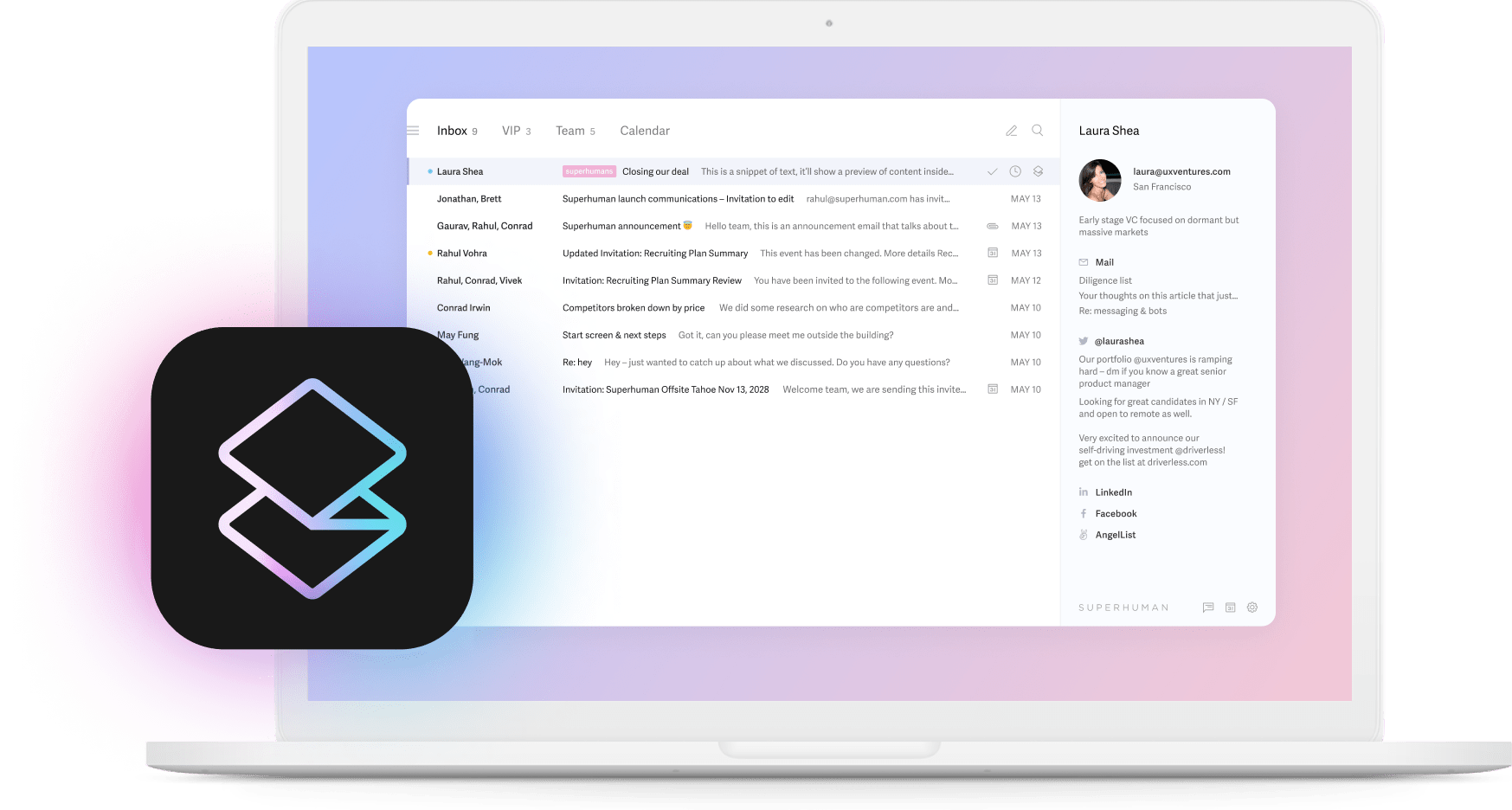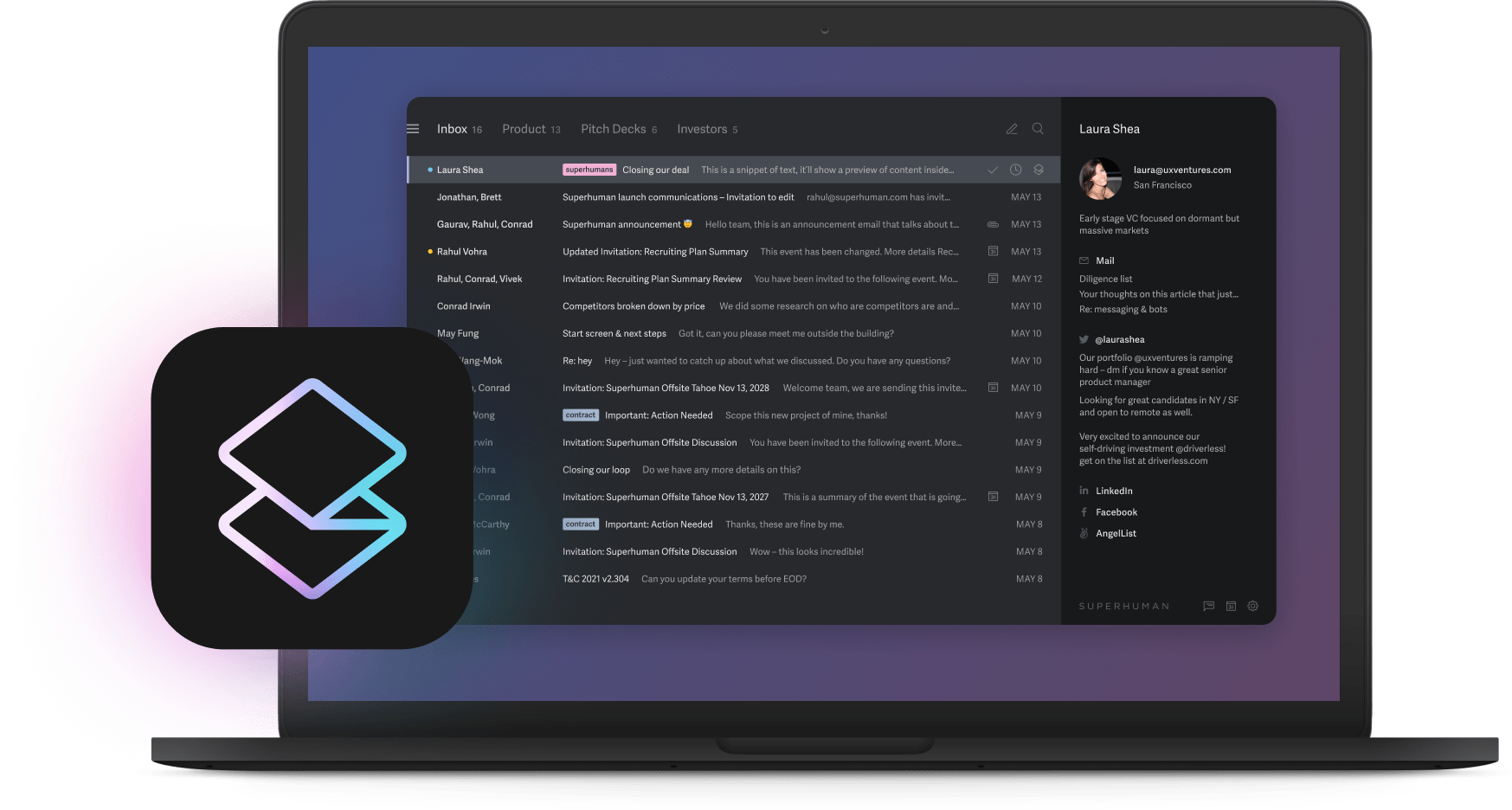
Looking for alternatives to Gmail? Want to evaluate if Superhuman is an upgrade over Gmail? You're in the right place.
Make no mistake. Superhuman is definitely an upgrade over Gmail. But this article isn’t going to be a long sales pitch. Rather, we'll explore the differences between Gmail and Superhuman so you can decide which email client is right for YOU.
By the end, you’ll see that this isn't an apples to apples comparison because Superhuman and Gmail are different at a fundamental level. Let’s dig in:
Overview: comparing Gmail to Superhuman
Before we get into a detailed analysis, let’s take a look at the overall situation and make some observations about just how different these tools are.
Gmail is built for everybody, and that’s pretty clear when you look at its market share, which is almost 30%.
Superhuman, on the other hand, is a specialized, premium tool built specifically for email and won’t rank (yet) on any email market share list. They are fundamentally different businesses.
Gmail is meant to democratize email, while Superhuman is built to enhance the email experience. Yes, both services allow you to send and receive email, but that’s pretty much where their similarities end. There are other comparisons of these email clients on the Internet that liken Gmail to a Prius and Superhuman to a Ferrari, but that's also inaccurate.
If Gmail is a Prius, Superhuman is a helicopter.
This is because Superhuman is not just another email client. It’s the embodiment of the Inbox Zero email philosophy. Superhuman is designed in a way that actually transforms how you use email, as opposed to just adding a nifty feature here or there.
Let’s break down both email clients and analyze which is right for you.
Gmail: great for basic needs and personal use
There are basically three reasons people use Gmail:
- It’s free and easy to use
- It was assigned to them at work
- The paid version connects seamlessly to Google’s app ecosystem (Google Workspace, formerly G Suite)
Nobody really wants to use Gmail—it’s viewed as a commodity and there’s absolutely nothing wrong with that. Gmail is a great tool if you only want to use it for the three reasons listed above.
In fact, there are several key benefits to using Gmail:
Little to no cost
Obviously, there is a free version of Gmail that you can sign up for and configure in just a few minutes. If you choose to add Google Workspace to add features like extra storage, custom domains, and customer support, you can still get started for as low as $6/month. Talk about cheap.
The Google ecosystem
If you add Google Workspace to your Gmail account, you instantly have access to all the apps many of us use on a daily basis: Sheets, Docs, Slides, Forms, Meet, etc. Depending on how you look at it, Gmail is almost a loss leader that feeds into a purchase of Google Workspace, and it’s a strategy that seems to be working—its cloud division earned $6.3 billion in revenue in Q3 of 2022, its highest grossing quarter to date.
Unfortunately, Google Workspace does very little to improve the actual Gmail experience, however it’s a primary driver of the use of Gmail.
Appointment scheduling
While this is technically a feature for Google Calendar, not Gmail, the two are so closely linked that it seems appropriate to mention it here. Obviously, this new feature is only available for Google Workspace customers.
Many people have dubbed this long-awaited feature the “Calendly killer” due to its ability to perform the exact same function natively.
The appointment scheduling feature allows you to set up a page that displays your availability to people outside your organization, allowing them to book meetings with you and add a video conference option (like Meet or Zoom).
You can can also customize your availability appears and how quickly people can book you based on set parameters. Read more on Google’s official help article.
If you find Calendly links pretentious, Gmail's appointment scheduling feature might be the next best thing. The caveat: You'll need to share your Google Calendar for this feature to work.
Advanced settings (formerly “Labs”)
As many Gmail power users know, there was a tab within the general settings called “Labs” that would enable you to turn on various pro features. One of the most popular Labs features was “Undo Send,” which has since been added to the native functionality of Gmail.
Many of the now-obsolete Labs features actually made their way into the core product including Schedule Send, Custom Keyboard Shortcuts, and Google Docs Preview. We covered all these features in our Gmail hacks guide.
Labs was sunset in 2017 and replaced with Advanced Settings, which still maintains a few popular features like Auto-Advance and Templates. While much more limited than Labs, Gmail power users appreciate the added functionality.
Optional Reading: How to unsend an email on Gmail.
Integrations
Without a doubt, the most attractive feature of Gmail (apart from the cost) is that it integrates with almost everything, from video conferencing apps to project management software. Additionally, there is an entire marketplace of add-ons that you can integrate with Gmail to add features to your liking. While some seem a bit peculiar (does anybody really want to integrate Slack into Gmail?) there are others that offer specific utility, such as the ability to track opens of your sent emails.
There are some downsides to Gmail add-ons, however. First, because these apps have access to your Google account, there is always an increased security risk. Additionally, add-ons can potentially interfere with one another’s functionality and cause Gmail to behave unexpectedly.
Issues with Gmail
While Gmail offers plenty of features and is arguably the standard for web-based email clients, it is not without drawbacks. Here are a few that stand out:
- Slow: The email service is notoriously slow, which frustrates users attempting to process large volumes of email
- Unnecessary widgets: There are dozens of buttons in the UI, most of which have nothing to do with email and you aren’t able to remove.
- Not intuitive: There is decent functionality to improve your email experience, however it’s not readily apparent how to set them up without digging through the settings.
Overall, Gmail is an incredible service, however much of its benefit lies in the fact that it connects to other necessary apps—there’s not as much consideration put into making the actual email experience better.
Now let’s take a look at Superhuman.
Superhuman: an entirely different email experience
Superhuman is designed to empower its users to get to Inbox Zero with speed, efficiency, and delight. In fact, more than half hit Inbox Zero within 4 hours of starting. Here are some of the features it uses to make that happen.
Speed
Paul Buchheit, the creator of Gmail, coined the term “100ms rule,” which indicates that any interaction that takes less than 100ms feels instantaneous. Above that, software users feel bogged down by ‘slow’ actions.
The team at Superhuman is obsessed with speed and has put in the engineering work to reduce latency to a mere 32ms—that’s 3x faster than Gmail.
In simple terms: Superhuman is the fastest email experience ever made.
Split Inbox
Speed is great, but in order to reach Inbox Zero in a timely manner, you still need an organization system. Split Inbox does just this and is arguably one of Superhuman’s most powerful features.
This feature allows you to divide your inbox into different areas of focus based on the types of email you receive most often. Think of it like Gmail tabs, but actually useful. The default splits are Important and Other, which sorts the inbox into two streams: Important collects emails coming directly from actual humans, while Other receives all automated emails.
But that’s only the beginning—based on your job role, you can configure your splits with pinpoint precision.


Are you a project manager keeping track of a thousand notifications per day? Configure splits based on software (Figma, Asana, Google Docs) and process all task-related emails together.
Are you a CEO who wants to respond quickly to investors, strategic partners, and media inquiries? Create a VIP list and never miss an opportunity.
The beauty of splitting your inbox is that it allows you to process emails without having to constantly switch context, which is what you’d have to do if you go through your emails chronologically.
The Split Inbox feature has quite the following, with Superhuman users regularly sharing their splits with each other on Twitter.
Keyboard shortcuts
While ‘nuts and bolts’ engineering is the best way to speed up the software itself, keyboard shortcuts are the best way to speed up the software user. In fact, a developer named Bruno Michels found that users can save up to 134 hours per year by using keyboard shortcuts instead of mouse clicks—that’s 17 work days!
Superhuman’s approach to hotkeys is legendary and comes with more than 100 default keyboard shortcuts (PDF cheat sheet here) that generate a ton of praise from email power users and productivity aficionados everywhere.
Snippets
Depending on your job, you may find yourself using the same sentences a lot—introductions, thank yous, proposals, meeting requests, etc. Or maybe you’re doing some cold outreach and you literally need to write the same email a few dozen times. Snippets dramatically reduces the time it takes to compose these messages.
Think of them as pre-built templates you can quickly insert into your emails. They can be full emails, paragraphs or phrases that you find yourself continually using. They can even include attachments, and can automatically add the right people to CC or BCC.
Snippets from Superhuman allow you to type more in less time, helping you get through your email blazingly fast.
Optional Reading: CC vs BCC: what do they mean and how to use them.
Design
While speed and functionality are top priorities in an email client, there is plenty that can be said about how the clean UI of Superhuman allows you to more easily enter a flow state while processing your email.
As you can see, it’s clear that when you have Superhuman open—whether the desktop app, web app, or mobile app—the act of email is the priority. There aren’t any distractions from the task at hand, which allows you to focus on the quality and speed of your responses.
This is in stark comparison to Gmail, as we mentioned earlier, that crowds your inbox with dozens of buttons and design elements that have nothing to do with email.
In closing, Gmail is a tool designed to help you send and receive emails, and it plugs in nicely with many other common functions of an office like calendars, video conferences, and document storage.
Superhuman is the fastest email experience ever made; meticulously crafted so that everything happens in 100ms or less. It’s specifically designed to help people with overloaded inboxes save time, be more responsive, and feel less anxiety while processing email.


